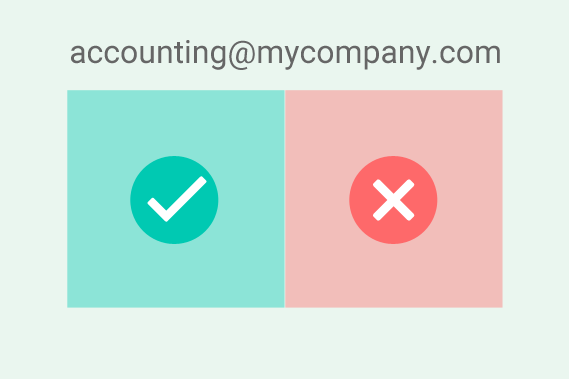
Your accounting email address is the center of your accounting cycle. It’s how vendors and customers connect to you. It’s the way you exchange invoice and payment information as well as resolve inquiries, disputes, and reconciliation.
Behind every accounting email address is a process. In a perfect world, it should be simple to understand, easy to follow, and responsive to your vendors and customers, but too often, it’s a hodge-podge of one-off, hard-to-follow rules, and procedures that cause delays, mistakes, and upset partners (and possibly your boss). So here are some essential do’s and don’ts to help you create the best email address for your accounting department.
Accounting Email Address Do’s
Think Process.
AR, AP, and payroll are different, and you should design your accounting email addresses to reflect these differences. The access rights, required actions, tracking of work, and keeping of records will vary for each. You want to be able to tailor your workflow to these differences. Having alignment between address and process makes this possible.
Plan for the future.
If you’re a sole proprietor, do you plan to have employees one day? If you’re a one-person department, do you plan to hire more people? What will your team and operations look like in the future? By planning for the future of your operations, you’ll be able to scale as the business requires.
Leverage Automation.
Unlike a personal email address which is very ad-hoc, an accounting email address has compliance and controls requirements to fulfill the accounting cycle. That makes it ripe for automation. Using generic email software like Outlook or Gmail puts the burden of compliance and controls on the staff through manual routines. Automation allows the team behind the accounting email address to focus on doing work rather than managing compliance.
Reinforce Compliance.
Once you have an address setup for connecting with vendors, customers, or employees, stick to it. If a vendor sends an invoice to the purchasing department, have the purchasing department instruct the vendor of the right AP email address. The same is true for other accounting email addresses. Compliance removes exceptions and errors from the process.
Accounting Email Address Don’ts
Use 3rd-party Email Addresses.
Outsourced services for accounting are popping up everywhere whether it’s for bookkeeping or bill pay. These service providers often instruct you to have vendors or customers send emails directly to their address such as yourcompay@theircompany.com. But what if you want to change to a new service? Once you do, you will disrupt the connection between your vendors, customers, or employees and your process, and it will take multiple accounting cycles to fix it – not to mention the extra work required. The best practice is to always have emails arrive at an address you control and then forward them to any 3rd-party addresses.
Correspond from Personal Email Address.
The most frequent disruption in the accounting cycle is correspondence from a personal email address. We all know that accounting personnel change frequently. Additionally, we all need a vacation and do get ill from time to time. Between turnover and out-of-office, lots of emails get lost, because vendors and customers send critical information to someone who’s not there. When that happens, it’s as if part of the accounting cycle entered into a black hole and is not found until something goes overdue. Don’t let your staff correspond using a personal email address.
If you’d like to pursue these best practices, evaluate Lockstep for your organization.
Lockstep enables you to build a process behind each of your accounting email addresses. With a team workspace for collaboration, workflow for automation, and deep integration into accounting software, Lockstep makes it easy, secure, and fast to work with vendors, customers, and employees.



